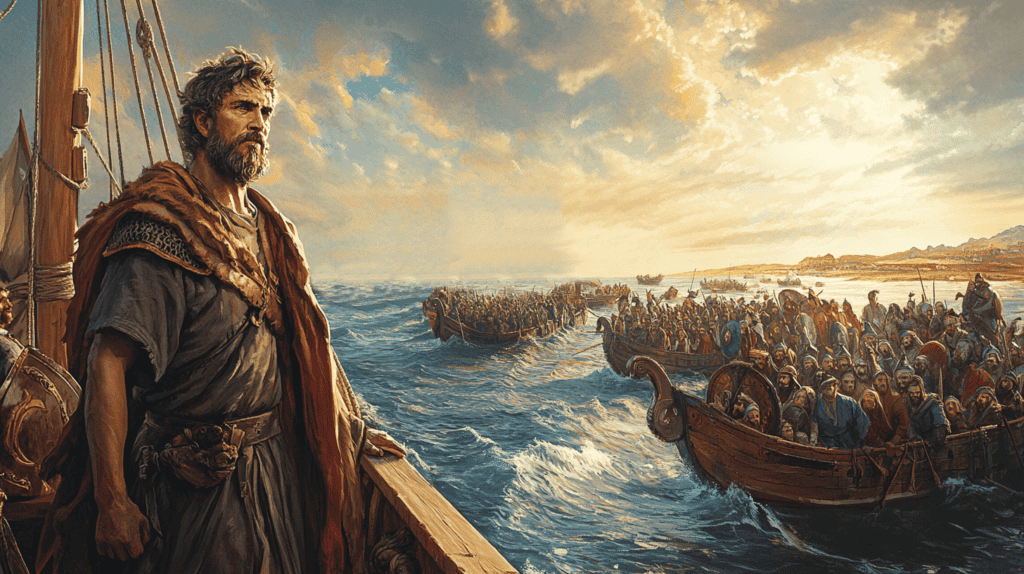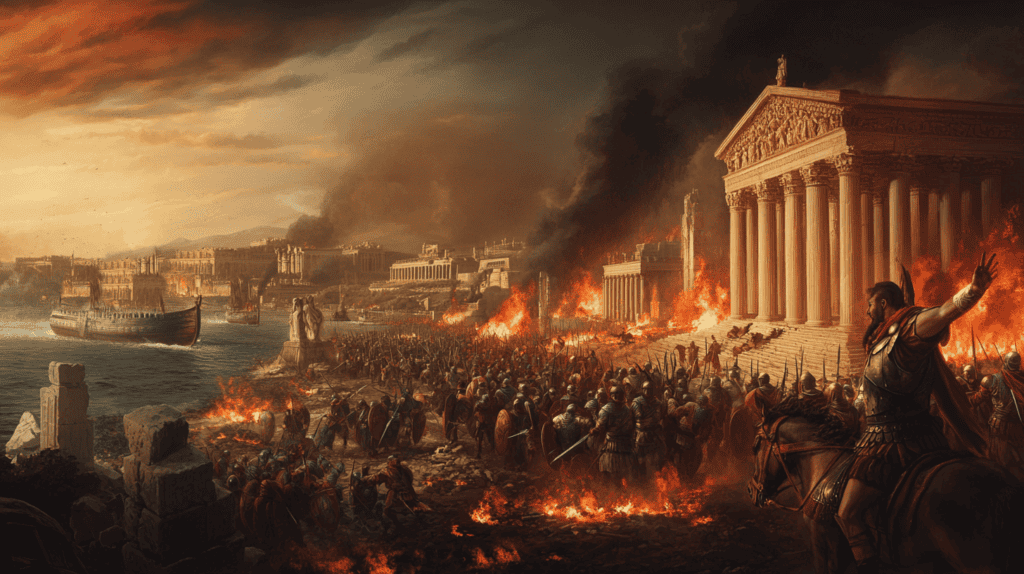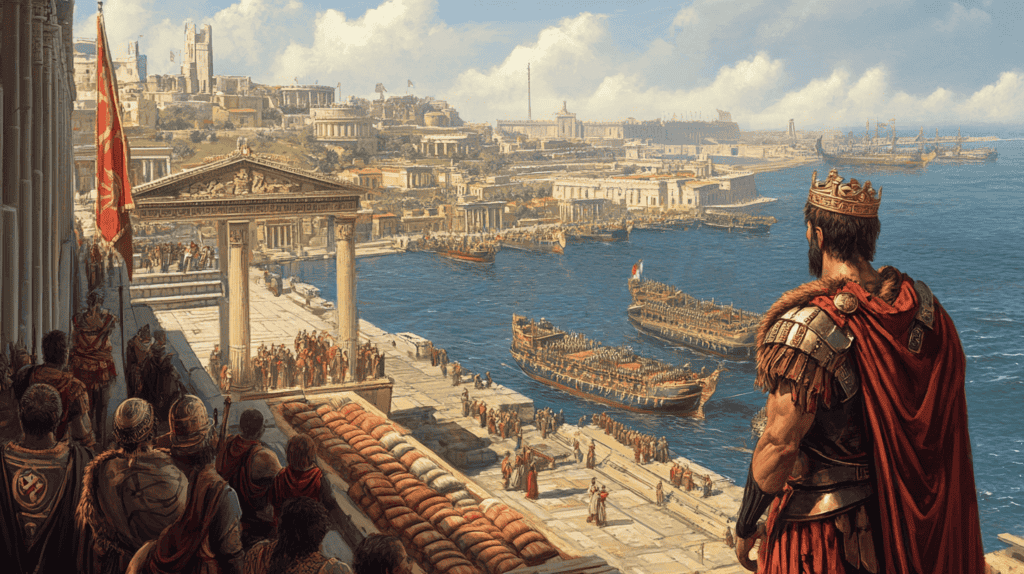
In the twilight years of the Western Roman Empire, a Germanic tribe known as the Vandals embarked on a daring campaign that would reshape the political landscape of the Mediterranean. Under the leadership of their cunning and ambitious king, Gaiseric, the Vandals launched an invasion of Roman North Africa in 429 CE, setting in motion a series of events that would ultimately sever the vital grain supply to Rome and hasten the empire’s decline.
The Rise of Gaiseric
Gaiseric ascended to the Vandal throne in 428 CE following the death of his half-brother, Gunderic. Unlike his predecessors, Gaiseric possessed a keen strategic mind and an insatiable appetite for power. He quickly recognized that the Vandals’ position in Hispania was precarious, constantly threatened by their more numerous Visigothic neighbors.
Determined to secure a better future for his people, Gaiseric began preparations for a bold move even before he became king. He set his sights on the prosperous Roman provinces of North Africa, which offered not only fertile lands but also a strategic position from which to control Mediterranean trade.
The Invasion of Africa
In 428/429 CE, Gaiseric led his people on an epic journey across the Strait of Gibraltar into North Africa. The size of this migration remains a subject of debate among historians, with estimates ranging from 20,000 to 80,000 people. Regardless of the exact numbers, this mass movement included not only Vandals but also Alans, Goths, and other Germanic peoples.

The reasons behind this invasion have been shrouded in mystery and controversy. One account suggests that Boniface, the Roman governor of Africa, invited the Vandals as allies against a potential Roman invasion. Another theory posits that Gaiseric, having been injured in a fall from a horse, decided to wage war by sea and sought to establish a naval base at Carthage.
Whatever the true motivation, Gaiseric’s timing was impeccable. He took advantage of the political turmoil within the Roman Empire, particularly the conflict between Boniface and the powerful general Aetius. This internal strife left the African provinces vulnerable to external threats.
The Vandal Conquest
Upon landing in Africa, Gaiseric’s forces quickly overran the Roman defenses. They seized lands from local Berbers and Romans near Tingi (modern-day Tangier) and spread across Mauritania. The Vandals’ advance was marked by savage atrocities and widespread destruction, particularly targeting the Catholic population and church buildings, as the Vandals were adherents of Arian Christianity.
In 430 CE, the Vandals laid siege to the city of Hippo Regius, where St. Augustine, one of the most influential figures in Western Christianity, was bishop. The siege lasted 14 months, during which Augustine passed away. The fall of Hippo Regius was a significant blow to Roman morale and control in the region.

The Fall of Carthage
Gaiseric’s capture of Carthage on October 19, 439 CE was a pivotal moment in the Vandal conquest of North Africa, dealing a severe blow to Roman power in the region. This audacious move came as a complete surprise to the Romans, who were caught entirely unprepared.
The Vandal king had previously concluded a peace treaty with the Roman Empire in 435 CE, which recognized Vandal control over parts of North Africa while maintaining Roman sovereignty over Carthage. However, Gaiseric was not content with this arrangement and bided his time, waiting for the right moment to strike.
Taking advantage of the fact that the Roman general Aetius was preoccupied with affairs in Gaul, Gaiseric launched his attack without any declaration of war. The Romans’ lack of vigilance proved fatal, as the Vandals swiftly overwhelmed the city’s defenses. Some accounts suggest that Gaiseric may have used trickery to gain entry into Carthage, though the exact details remain unclear.

Upon capturing the city, the Vandals immediately set about consolidating their power. Gaiseric seized a large portion of the Western Roman navy docked in Carthage’s port, significantly bolstering his maritime capabilities. This acquisition would prove crucial in the Vandals’ future naval dominance of the Mediterranean.
The fall of Carthage had profound religious implications as well. Gaiseric, an adherent of Arian Christianity, exiled the city’s Catholic bishop, Quodvultdeus, to Naples. This action foreshadowed the religious persecution that would follow under Vandal rule.
Gaiseric wasted no time in establishing Carthage as the new capital of his kingdom. The city’s strategic location and existing infrastructure made it an ideal base from which to expand Vandal power. By taking control of this vital port, Gaiseric gained access to the lucrative grain trade and positioned himself to challenge Roman control over Mediterranean shipping lanes.

The capture of Carthage marked a turning point in the history of the Western Roman Empire. It deprived Rome of crucial tax revenues and resources, further weakening its ability to defend its remaining territories and presaged Rome’s eventual collapse.
The Sack of Rome
Gaiseric’s most audacious act came in 455 CE when he led the Vandals in a sack of Rome itself. This event, while not as destructive as the infamous Visigothic sack of 410 CE, was nonetheless a profound humiliation for the once-mighty empire. The Vandals plundered the city for two weeks, stripping it of valuable treasures, including the golden roof tiles of the Temple of Jupiter Capitolinus.

Gaiseric’s Diplomatic Maneuvers
A particularly cruel incident involves Gaiseric’s treatment of his daughter-in-law, a Visigothic princess. When a more advantageous marriage prospect arose for his son Huneric, Gaiseric allegedly allowed the princess to be accused of attempting to poison him. As punishment, her ears and nose were cut off, and she was sent back to her father. This act not only freed Huneric for a new marriage but also sparked enmity between the Vandals and Visigoths.
Yet despite his reputation for brutality, Gaiseric proved to be a shrewd diplomat. He skillfully played the Eastern and Western Roman Empires against each other, alternating between aggression and conciliation to maintain his kingdom’s independence.

In 442 CE, Gaiseric negotiated a treaty with Valentinian III, which officially recognized the Vandal kingdom in North Africa. This agreement granted the Vandals legitimacy and allowed Gaiseric to consolidate his rule. However, true to his nature, Gaiseric continued to launch raids and expand his influence whenever the opportunity arose.
Roman Attempts at Reconquest
The Roman Empire made several attempts to reclaim its lost African territories. In 460 CE, Western Emperor Majorian launched a major expedition against the Vandals. However, Gaiseric, ever vigilant, launched a preemptive strike that destroyed or captured most of the Roman fleet.
The most significant attempt came in 468 CE when the Eastern and Western Empires united in a massive naval assault on the Vandal kingdom. This expedition, led by Basiliscus, was one of the largest military operations in ancient history. Yet, through a combination of cunning tactics and possibly treachery, Gaiseric managed to destroy 600 Roman ships and capture many others. This devastating defeat forced the Romans to sue for peace, essentially accepting Gaiseric’s terms and the Vandals’ continued presence in Africa.

Legacy of Gaiseric and the Vandal Kingdom
Gaiseric’s reign, which lasted nearly 50 years until his death in 477 CE, transformed the Vandals from a relatively minor Germanic tribe into a major Mediterranean power. His strategic acumen, military prowess, and diplomatic skills allowed him to outmaneuver the declining Roman Empire and establish a kingdom that would endure for nearly a century after his death.
The Vandal conquest of North Africa accelerated the decline of the Western Roman Empire. By cutting off the grain supply and constantly harassing Roman territories, Gaiseric and his people contributed significantly to the empire’s economic and military woes. The loss of Africa deprived Rome of crucial tax revenues and resources, further weakening its ability to defend its remaining territories.




